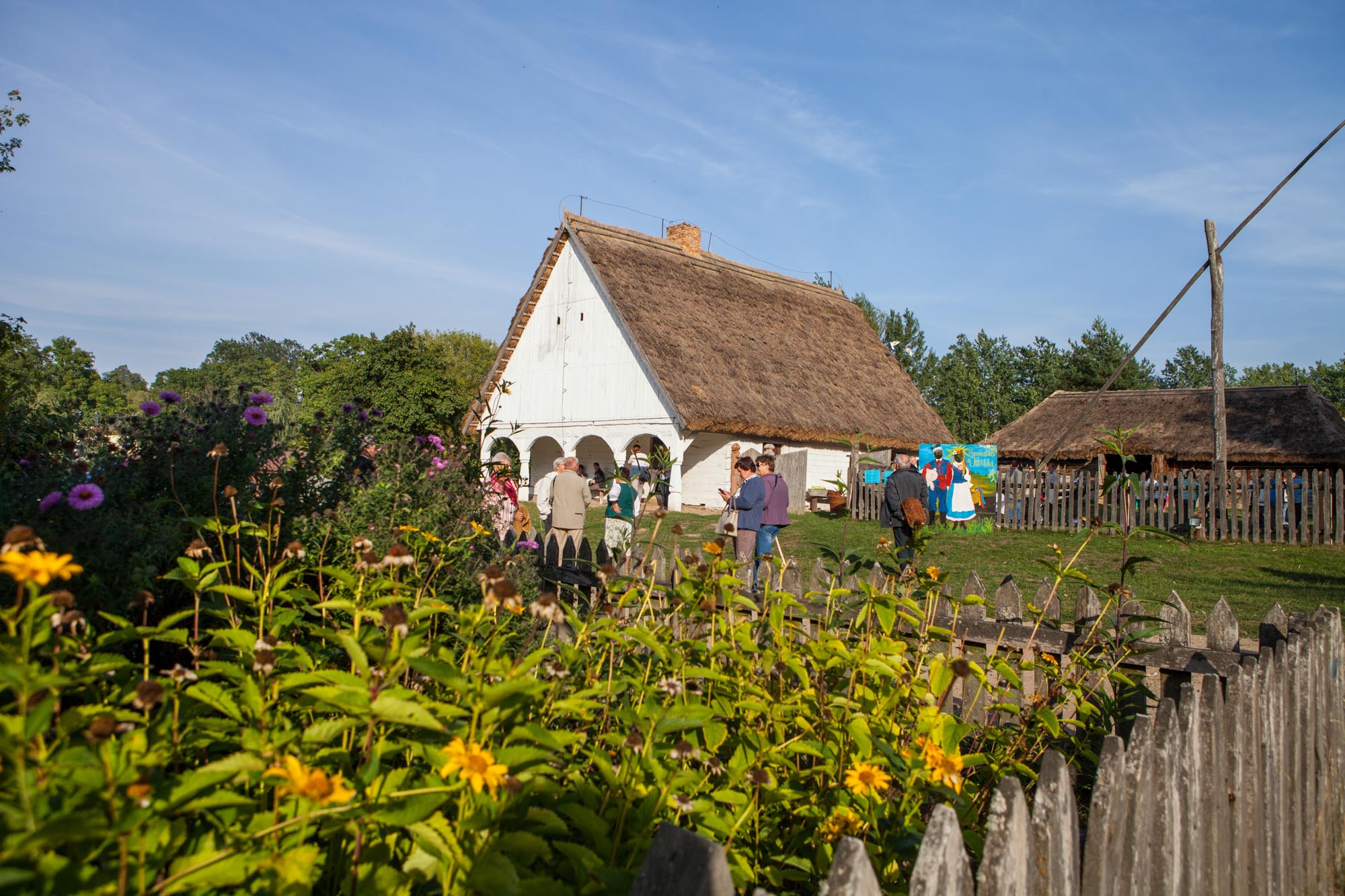Peaceful village, merry village
In accordance with tradition
Kłóbka
Old cottages, barns, smithy, potter’s workshop, rotating windmill, inn, depot, school… A 19th-century village reconstructed at the Kuyavian- Dobrzyń Ethnographic Park in Kłóbka is reminiscent of a scene from a folk artist’s painting. Making butter in churns, groats in mortars, oil pressing, flailing, and washing in washtubs cause that the painting becomes alive. The heritage park is worth visiting during meetings within the series ”Old village life”. Workshops teem with craftsmen’s work, and women do household works. In the park on the Lubieńka Creek, there is the manor of the Orpiszewski family from the mid-19th century. Its interiors fully present the atmosphere of a landowner’s mansion.
Lower Vistula River Valley
Open spaces reaching embankments of the Vistula River, wayside alleys of fruit trees, orchards and gardens adjoining to houses. The Lover Vistula River Valley is the region’s exceptionally bewitching part – enchanting with its landscapes, tradition and historical sites in villages. The natural scenery of the Vistula Valley – one of the few wild rivers of Europe, is protected within the Group of Chełmiński and Nadwiślański Landscape Parks. In the fertile and hospitable lands of the Lower Vistula River Valley there are plenty of people, who know the value of
their heritage – shaped by Prussians, Polish people, Germans, people coming from Switzerland, and Hauländer settlers, who had no equals in land cultivation, animal breeding and orcharding. Within cultivation of the old tradition, an orchard with old varieties of fruit trees has been opened in Chrystkowo. In the local Mennonite wooden hut from the year 1770, the last Mennonite presents the history of this place. In Gruczno, around the old mill surrounded with hills, where regional sheep – “heather” sheep – are grazed everyday, the Taste Festival is held in August, which attracts gourmets from all over Poland. In September, Strzelce Dolne is worth visiting owing to its Plum Holiday to taste traditional plum confection and to take a closer look at the process of frying it – in huge boilers with wooden mixers, over fire fed
by deciduous timber. In Topolno, taste connoisseurs are awaited by the family vineyard Winnica przy Talerzyku, where wines are made of grapes ripening on the hills on the Vistula River.

Brown treasure, dream catchers and ritual canibalism
Thematic villages
The Mining Village in Piła-Młyn was established right after the ground under the feet of the local people started to collapse. The oldest residents remembered the old mine, and young people believed that though there was no brown coal any more – mined here at the turn of the 20th century – they found a real treasure by chance. The unique history of this place is told by the Old Treasurer, leading to the reconstructed entrances to old wells. In the village one can participate in a feast full of undergrowth endowments, and even in the ”Foreman’s Wedding”. In Wymysłowo in the Tuchola Coniferous Forests we will be surprised by the Museum of North American Indians,
presenting memorabilia of Sat Okh (Long Feather). The son of a Polish woman and an Indian chief from the Shawnee tribe visited this place eagerly. A wigwam, costumes, Indian accessories, and tribal music are the colourful setting for the interesting history of the Indian culture and the life of Sat Okh, who was a guest of the museum many times.
Cultural cannibalism in a small village on the Vistula River? Though it sounds unbelievably, Gzin has got irrefutable scientific proof of its remote Lusatian past. Over 60 holes with relics of victims of cannibalism were found within this settlement. Nowadays, the shameful rituals have been replaced with graceful traditions and customs, such as Midsummer Night, and plucking down – consisting in preparation of eiderdowns, i.e. important elements of brides’ dowries.

Museum of time and space
Noteć River Valley
The characteristic Noteć River landscape, people’s work rooted in tradition, and culinary heritage – everything that creates the unique atmosphere of this place – are a part of the network called ”Ecomuseum of the Noteć River Valley”. On the ecomuseum trail, we will familiarise ourselves with how people had built their bonds with their ”little homeland”, reach the roots of Krajna and Pałuki Regions, and experience the local delicacies gathered in the ”Pałuki Cupboards”.
Thematic villages in Kujawsko-Pomorskie
Borowiacy People’s Village Bread Village
Bird’s Village Floral Village Apple Tree Village Honey Village Mushroom Village Mining Village Rocket Village Railway Village Rituals Village
Maciej’s Soul Village Nut Village
Fruit Village
In the regional pantry
For centuries, fertile Kuyavia and hospitable Pomerania had served as the pantry of Poland. Nowadays, the ”Culinary Heritage of Kuyavia and Pomerania” gets out of our tradition long forgotten recipes, the best components and the thing that’s most valuable – the huge enthusiasm of the people who make them. The regional resources include products made of traditional cereals – emmer wheat, einkorn wheat and spelt, natural fruit and vegetable juices, traditional mustard, excellent cold pressed oils, and dulce de leche. Our region is also famous for Kołuda white geese breeding. Almost 20 restaurants on the Kuyavian-Pomeranian Culinary Goose Trail cultivates the Old Polish custom of preparing goose, which used to prevail on Polish tables in the past.



